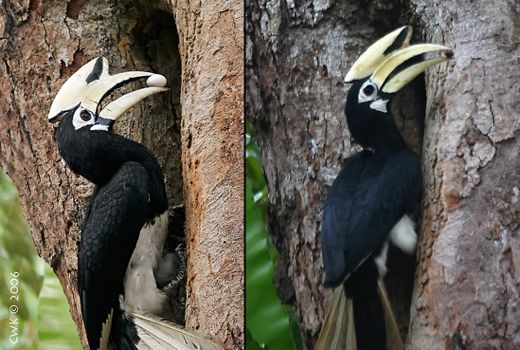There are slightly more than a dozen Oriental Pied Hornbills (Anthracoceros albirostris) in Singapore’s offshore island of Pulau Ubin. There they breed regularly, nesting in cavities found high up along the trunks of old trees.
Prior to breeding, a pair would indulge in courtship feeding and they would go prospecting for a suitable nesting cavity. The male bird would lure the female to the cavity, flying back and forth between the perch and the cavity. He would need to convince his mate that he is capable of feeding her once she is sealed up inside. He needs to demonstrate feeding at the cavity, sometimes placing food inside.
He would even enter the cavity in an effort to convince her that it is alright. This may go on for a number of days. But once she is convinced, she will fly over and inspect it. She would even clean up the inside of the cavity.
Then the birds would mate and the female would be sealed inside leaving only a narrow slit for the male to pass her food. She lays her eggs and sheds her feathers.
In the images above, the male is bringing an egg (left) and probably a fig (right) to his mate and chicks sealed inside the nest.
Detials of feeding is shown in the image on the left where the male is passing on food to the chicks sealed inside a cavity high up an old durian tree (Durio zibethinus) growing within the compound of a house in Pulau Ubin. The bird flew in several times a day, bringing food for the imprisoned occupants. Food includes figs, eggs, insects and reptiles.
After 29 incubation days and almost 2 months of living together in a confined space, the female reopens the cavity entrance and free the young birds. The parents will accompany them as they discover their new environment.
Input by YC, images by YC (top, middle right) and Dr Jonathan Cheah Weng Kwong (middle left, bottom).












2 Responses
An update … there are at least 20-30 hornbills on Ubin now. Studies have shown that it is the female which seals herself in with material brought by the male.